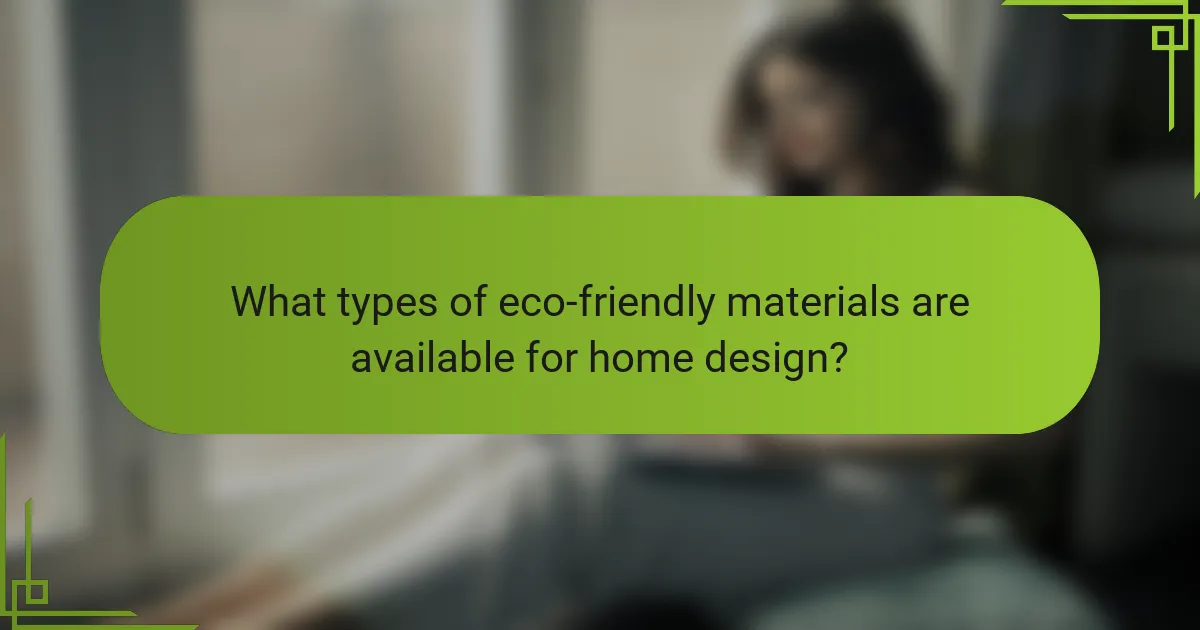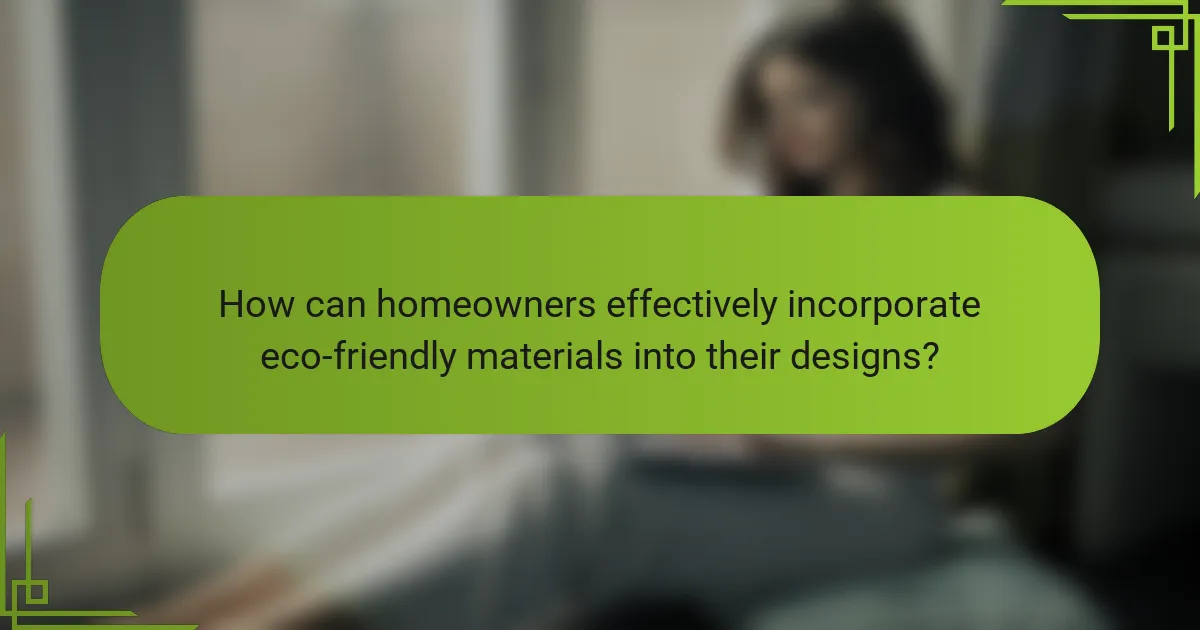
What are Eco-Friendly Materials in Home Design?
Eco-friendly materials in home design are sustainable resources that minimize environmental impact. These materials include bamboo, reclaimed wood, recycled metal, and low-VOC paints. Bamboo grows rapidly and absorbs carbon dioxide, making it a renewable resource. Reclaimed wood repurposes existing timber, reducing deforestation and waste. Recycled metal conserves energy and resources compared to new metal production. Low-VOC paints improve indoor air quality by reducing harmful emissions. Using these materials can lead to energy-efficient homes and lower carbon footprints. The adoption of eco-friendly materials in home design promotes sustainability and environmental responsibility.
Why is it important to explore sustainable options?
Exploring sustainable options is important for reducing environmental impact. Sustainable materials minimize resource depletion and pollution. They help conserve energy and water during production. Using eco-friendly materials can enhance indoor air quality. Sustainable choices often lead to healthier living spaces. They can also improve energy efficiency in homes. This results in lower utility bills for homeowners. Research shows that sustainable building practices can increase property value.
What defines eco-friendly materials?
Eco-friendly materials are substances that have a minimal impact on the environment. They are sourced sustainably and produced with low energy consumption. These materials often come from renewable resources, such as bamboo or recycled products. They help reduce waste and pollution during their lifecycle. Eco-friendly materials also contribute to healthier indoor air quality. They typically contain fewer harmful chemicals than conventional materials. For example, low-VOC paints are safer for both people and the planet. The use of eco-friendly materials supports sustainable practices in construction and design.
How do eco-friendly materials differ from traditional materials?
Eco-friendly materials differ from traditional materials primarily in their environmental impact. Eco-friendly materials are sourced from renewable resources and are biodegradable. Traditional materials often rely on non-renewable resources and can contribute to pollution. For example, bamboo is a rapidly renewable resource, while conventional wood may come from deforested areas. Furthermore, eco-friendly materials typically use less energy during production. This contrasts with traditional materials, which often involve energy-intensive processes. Additionally, eco-friendly options often contain fewer harmful chemicals. Traditional materials may release volatile organic compounds (VOCs) over time. Studies have shown that using eco-friendly materials can significantly reduce the carbon footprint of construction.
What are the key benefits of using eco-friendly materials?
Eco-friendly materials offer several key benefits. They reduce environmental impact by minimizing waste and pollution. These materials often come from renewable resources, which helps conserve natural resources. Using eco-friendly materials can improve indoor air quality, as they typically contain fewer harmful chemicals. They can also enhance energy efficiency in buildings, leading to lower utility costs. Additionally, eco-friendly materials often have a longer lifespan, reducing the need for frequent replacements. Studies show that buildings using sustainable materials can increase property value. Overall, choosing eco-friendly materials supports sustainable living and promotes a healthier environment.
How do these materials impact the environment?
Eco-friendly materials positively impact the environment by reducing waste and conserving resources. These materials often come from renewable sources, minimizing depletion of non-renewable resources. They typically require less energy to produce compared to conventional materials, leading to lower greenhouse gas emissions. Additionally, many eco-friendly materials are biodegradable or recyclable, reducing landfill contributions. For example, bamboo grows quickly and sequesters carbon, making it a sustainable choice. Using recycled materials, such as reclaimed wood, also decreases the demand for new resources. Studies show that eco-friendly construction can reduce overall environmental footprints significantly.
What health benefits do eco-friendly materials provide for occupants?
Eco-friendly materials provide several health benefits for occupants. These materials often contain fewer harmful chemicals compared to conventional options. For instance, low-VOC (volatile organic compounds) paints and finishes reduce indoor air pollution. This can lead to fewer respiratory issues and allergies among occupants. Additionally, natural materials like bamboo and cork can improve indoor air quality. They are less likely to harbor mold and allergens. Studies show that environments with eco-friendly materials promote better mental well-being. Occupants report lower stress levels and improved mood in such spaces. Overall, eco-friendly materials contribute to a healthier living environment.

What types of eco-friendly materials are available for home design?
Eco-friendly materials for home design include bamboo, reclaimed wood, recycled metal, and natural stone. Bamboo is a fast-growing plant that is sustainable and durable. Reclaimed wood repurposes old timber, reducing waste and preserving forests. Recycled metal, such as aluminum, minimizes energy consumption during production. Natural stone, sourced responsibly, has a long lifespan and low environmental impact. These materials contribute to energy efficiency and reduce carbon footprints in construction and design.
Which natural materials are considered sustainable?
Sustainable natural materials include bamboo, cork, hemp, and reclaimed wood. Bamboo grows rapidly and can be harvested without killing the plant. Cork is harvested from the bark of cork oak trees, allowing them to continue growing. Hemp requires minimal pesticides and grows quickly, making it an eco-friendly option. Reclaimed wood is sourced from old buildings or furniture, reducing the need for new timber. These materials contribute to sustainable practices by minimizing environmental impact and promoting resource conservation.
What are the benefits of using bamboo in home design?
Bamboo offers numerous benefits in home design. It is a highly sustainable material due to its rapid growth rate. Bamboo can grow up to 35 inches within a single day. This makes it a renewable resource that reduces deforestation.
Additionally, bamboo is strong and durable. It has a tensile strength comparable to steel. This strength allows for the construction of sturdy structures. Bamboo is also lightweight, which makes it easy to handle and transport.
Furthermore, bamboo has natural moisture resistance. This property helps prevent mold and mildew in humid environments. Its aesthetic appeal adds a unique, natural look to home interiors.
Bamboo can be used in various applications, including flooring, furniture, and cabinetry. Its versatility makes it suitable for diverse design styles. Overall, using bamboo in home design promotes sustainability while providing functional and aesthetic advantages.
How does reclaimed wood contribute to sustainability?
Reclaimed wood contributes to sustainability by reducing the demand for new timber. This practice minimizes deforestation and preserves natural habitats. It also decreases waste by repurposing wood from old structures, preventing it from ending up in landfills. According to the U.S. Environmental Protection Agency, wood waste accounts for over 10% of landfill materials. Additionally, using reclaimed wood often requires less energy compared to processing new wood. This energy efficiency helps lower carbon emissions. Overall, reclaimed wood supports eco-friendly practices and promotes resource conservation.
What innovative materials are emerging in the eco-friendly market?
Biodegradable plastics are emerging in the eco-friendly market. These materials decompose naturally, reducing landfill waste. Mycelium, derived from fungi, is another innovative option. It serves as a sustainable alternative to traditional packaging and insulation. Recycled ocean plastics are also gaining traction. They help reduce marine pollution while creating durable products. Hemp-based materials are being used for textiles and construction. Hemp grows quickly and requires fewer resources than conventional crops. Bamboo is popular for its rapid growth and versatility. It can be used in furniture, flooring, and more. These innovative materials contribute to sustainability in design and construction.
How do recycled materials enhance sustainability in construction?
Recycled materials enhance sustainability in construction by reducing waste and conserving natural resources. They minimize the demand for new raw materials, which often require extensive extraction processes. For example, using recycled steel can save up to 75% energy compared to producing new steel. Additionally, recycled materials often have a lower carbon footprint. This contributes to a decrease in greenhouse gas emissions associated with construction. Incorporating these materials supports the circular economy by promoting reuse and reducing landfill waste. Studies show that buildings using recycled content can have improved environmental performance ratings. Overall, recycled materials play a crucial role in creating sustainable construction practices.
What role do bio-based materials play in eco-friendly design?
Bio-based materials are essential in eco-friendly design. They reduce reliance on fossil fuels and minimize environmental impact. These materials are derived from renewable resources, such as plants and agricultural waste. Their use contributes to lower carbon emissions during production. For example, bio-based plastics can reduce greenhouse gas emissions by up to 50% compared to conventional plastics. Additionally, bio-based materials often have a smaller ecological footprint. They can be biodegradable or compostable, enhancing sustainability. Incorporating these materials supports a circular economy by promoting resource efficiency. This approach aligns with increasing consumer demand for sustainable products.

How can homeowners effectively incorporate eco-friendly materials into their designs?
Homeowners can effectively incorporate eco-friendly materials into their designs by selecting sustainable options. They should prioritize materials with low environmental impact, such as bamboo, reclaimed wood, or recycled metal. These materials reduce waste and promote sustainability. Homeowners can also use non-toxic paints and finishes to enhance indoor air quality. Additionally, choosing local materials minimizes transportation emissions. Integrating energy-efficient appliances further complements eco-friendly designs. Research shows that using sustainable materials can reduce a home’s carbon footprint significantly. For instance, a study from the National Renewable Energy Laboratory found that sustainable building practices can lower energy costs by up to 30%.
What are some practical tips for selecting sustainable materials?
To select sustainable materials, prioritize those with minimal environmental impact. Look for materials that are renewable, such as bamboo and cork. Choose recycled materials, which reduce waste and conserve resources. Verify certifications like FSC for wood or GOTS for textiles, ensuring responsible sourcing. Consider the life cycle of materials, including their durability and recyclability. Evaluate local sourcing to reduce transportation emissions. Research the production processes to avoid harmful chemicals. Lastly, assess the overall embodied energy of materials to understand their environmental footprint.
How can homeowners assess the environmental impact of materials?
Homeowners can assess the environmental impact of materials by evaluating their life cycle. This includes examining the extraction, production, use, and disposal phases. Tools like life cycle assessment (LCA) provide detailed insights into resource consumption and emissions. Homeowners should also consider certifications such as Energy Star or LEED. These indicate compliance with environmental standards. Research shows that materials with lower embodied energy are more sustainable. For example, using recycled materials significantly reduces environmental impact. Homeowners can also consult local guidelines and databases for eco-friendly materials. This ensures informed choices that contribute to sustainability.
What certifications should homeowners look for in eco-friendly products?
Homeowners should look for certifications such as Energy Star, USDA Organic, and Green Seal in eco-friendly products. Energy Star indicates energy efficiency in appliances and building materials. USDA Organic certification ensures products are made from organic materials, free from synthetic pesticides. Green Seal certifies products based on environmental standards, focusing on sustainability and safety. These certifications provide assurance that products meet specific eco-friendly criteria. They help consumers make informed choices that support environmental sustainability.
What are common misconceptions about eco-friendly materials?
Common misconceptions about eco-friendly materials include the belief that they are always more expensive. In reality, many eco-friendly materials can be cost-competitive with traditional options. Another misconception is that eco-friendly materials lack durability. Numerous studies show that materials like bamboo and recycled steel are highly durable. Some people think eco-friendly materials are limited in variety. However, the market offers a wide range of options, including sustainable wood, recycled glass, and natural fibers. Lastly, many assume that eco-friendly materials are not aesthetically pleasing. This is false, as many designs showcase the beauty of natural materials, enhancing home aesthetics.
Why do some people believe eco-friendly materials are more expensive?
Some people believe eco-friendly materials are more expensive due to higher production costs. Sustainable materials often require specialized processes and sourcing from environmentally responsible suppliers. This can lead to increased prices compared to conventional materials. Additionally, the demand for eco-friendly options has grown, which can drive up costs. According to a study by the National Association of Home Builders, eco-friendly materials can be 10-15% more expensive than traditional alternatives. However, the long-term savings on energy and maintenance can offset these initial costs.
How can homeowners overcome perceived limitations of sustainable options?
Homeowners can overcome perceived limitations of sustainable options by educating themselves on the benefits of eco-friendly materials. Many sustainable materials are now competitively priced compared to traditional options. Homeowners can also seek out local suppliers to reduce transportation costs and emissions. Utilizing government incentives and rebates can make sustainable choices more affordable. Research shows that sustainable homes can increase property value by up to 9%. Additionally, homeowners can consult with professionals who specialize in sustainable design. This guidance can help identify the best materials for their specific needs. Engaging in community workshops can also provide valuable insights and support.
What are the best practices for maintaining eco-friendly materials in home design?
To maintain eco-friendly materials in home design, prioritize regular cleaning with non-toxic products. This prevents buildup of dirt and harmful substances. Use natural fiber brushes or cloths to avoid damaging surfaces. Ensure proper ventilation to reduce moisture, which can harm materials like bamboo or reclaimed wood. Repair any damages promptly to extend the lifespan of eco-friendly materials. Store materials in climate-controlled environments to prevent degradation. Choose finishes and treatments that are low in volatile organic compounds (VOCs) for better air quality. Regularly inspect materials for signs of wear and tear to address issues early. Following these practices helps sustain the integrity and appearance of eco-friendly materials.
How can homeowners ensure the longevity of eco-friendly materials?
Homeowners can ensure the longevity of eco-friendly materials by implementing proper maintenance practices. Regular cleaning helps prevent the buildup of dirt and grime. Using suitable cleaning agents that are non-toxic maintains the integrity of the materials. Additionally, applying protective coatings can enhance durability against environmental factors. Homeowners should also avoid exposing materials to extreme temperatures or moisture. Selecting high-quality eco-friendly products designed for longevity is crucial. Research shows that well-maintained eco-friendly materials can last significantly longer than their conventional counterparts. For example, bamboo flooring, when properly cared for, can last over 50 years.
What cleaning and maintenance tips are recommended for sustainable materials?
Sustainable materials require specific cleaning and maintenance practices to preserve their integrity. Use non-toxic, biodegradable cleaners to avoid harmful chemicals. Regularly dust surfaces with a microfiber cloth to prevent buildup. For wood, apply natural oils like linseed or tung oil for conditioning. Avoid abrasive materials that can damage surfaces. Rinse textiles with cold water and air dry to maintain their quality. For stone surfaces, use a pH-balanced cleaner to prevent erosion. Follow manufacturer guidelines for specific materials, as they provide tailored care instructions. These practices ensure longevity and sustainability of eco-friendly materials.
Eco-friendly materials are sustainable resources used in home design that minimize environmental impact. This article explores various eco-friendly materials, such as bamboo, reclaimed wood, recycled metal, and low-VOC paints, highlighting their benefits, including improved indoor air quality, energy efficiency, and reduced carbon footprints. It also discusses the importance of selecting sustainable options, the differences between eco-friendly and traditional materials, and provides practical tips for homeowners on incorporating and maintaining these materials effectively. Additionally, the article addresses misconceptions about eco-friendly materials and their role in promoting a healthier living environment.
